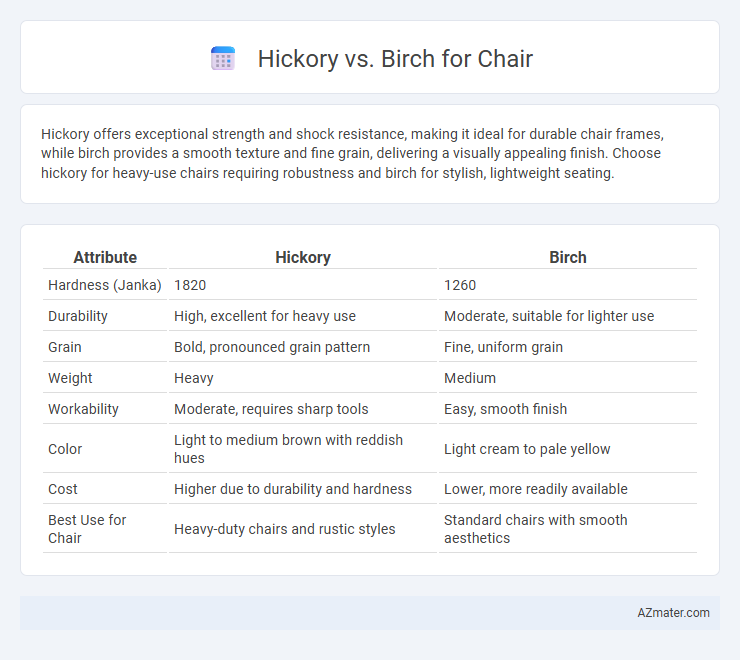Hickory offers exceptional strength and shock resistance, making it ideal for durable chair frames, while birch provides a smooth texture and fine grain, delivering a visually appealing finish. Choose hickory for heavy-use chairs requiring robustness and birch for stylish, lightweight seating.
Table of Comparison
| Attribute | Hickory | Birch |
|---|---|---|
| Hardness (Janka) | 1820 | 1260 |
| Durability | High, excellent for heavy use | Moderate, suitable for lighter use |
| Grain | Bold, pronounced grain pattern | Fine, uniform grain |
| Weight | Heavy | Medium |
| Workability | Moderate, requires sharp tools | Easy, smooth finish |
| Color | Light to medium brown with reddish hues | Light cream to pale yellow |
| Cost | Higher due to durability and hardness | Lower, more readily available |
| Best Use for Chair | Heavy-duty chairs and rustic styles | Standard chairs with smooth aesthetics |
Introduction to Hickory and Birch as Chair Materials
Hickory and birch are both popular hardwoods used for chair construction due to their strength and durability. Hickory is renowned for its exceptional hardness and shock resistance, making it ideal for heavy-use furniture, while birch offers a smooth, fine grain and lighter weight, providing a balance of sturdiness and aesthetic appeal. Both woods can be finished beautifully but differ in texture and color, influencing the final look and feel of the chair.
Key Characteristics of Hickory Wood
Hickory wood is renowned for its exceptional hardness and shock resistance, making it ideal for sturdy chair construction that withstands daily use. Its rich, varied grain patterns and color range from pale to reddish-brown add a warm, rustic aesthetic to furniture. Hickory's durability and strength surpass many hardwoods, offering excellent longevity compared to birch.
Distinct Properties of Birch Wood
Birch wood, known for its fine grain and pale color, offers exceptional strength and durability, making it an ideal choice for chair construction. Its smooth texture allows for a polished finish that enhances aesthetic appeal without compromising sturdiness. Compared to hickory, birch provides a consistent density that resists wear, ensuring long-lasting furniture pieces.
Durability: Hickory vs Birch Chairs
Hickory chairs offer superior durability due to their dense grain structure and high resistance to wear, making them ideal for frequently used furniture. Birch chairs provide moderate durability with a smooth finish and good shock resistance, but they are generally softer and more prone to dents compared to hickory. For long-lasting chair construction, hickory's strength and resilience make it a better choice than birch.
Weight and Density Comparison
Hickory is a dense hardwood with an average density of about 830 kg/m3, providing substantial weight and strength ideal for durable chairs. Birch, with a slightly lower density around 670 kg/m3, offers a lighter option while maintaining good structural integrity. The higher density of hickory makes chairs heavier and more resistant to wear, whereas birch chairs are easier to move due to their reduced weight.
Aesthetic Appeal and Grain Patterns
Hickory offers a bold, striking aesthetic with prominent variations in color and strong, dramatic grain patterns that create a rustic and rugged look for chairs. Birch presents a smoother, more uniform appearance with fine, subtle grain lines and a lighter color palette, lending a contemporary and clean finish. Choosing between hickory and birch depends on whether a chair requires a robust, textured visual impact or a sleek, understated elegance.
Ease of Workability and Finishing
Hickory offers excellent durability but is dense and hard, making it more challenging to work with for chair construction, requiring sharp tools and more effort in cutting and shaping. Birch is easier to carve and shape due to its fine grain and softer texture, allowing for smoother workability and cleaner edges in detailed chair components. When finishing, birch accepts stains and paints evenly, resulting in a smooth finish, whereas hickory's varied grain can make uniform finishing more complex but yields a distinctive, rustic appearance.
Cost Differences Between Hickory and Birch Chairs
Birch chairs typically cost less than hickory chairs due to birch's faster growth rate and greater availability, making it a more economical choice for furniture production. Hickory, known for its exceptional hardness and durability, commands a higher price because of the increased labor and time required for craftsmanship. Price differences can range from 15% to 30%, reflecting the varying material properties and overall market demand.
Best Use Cases for Hickory and Birch Chairs
Hickory chairs excel in durability and shock resistance, making them ideal for high-traffic areas and rustic furniture where longevity is essential. Birch chairs offer a smooth, fine grain with a lighter appearance, perfect for modern or Scandinavian-style interiors that prioritize aesthetics and ease of finishing. Both woods provide sturdy seating, but hickory suits heavy-use environments, while birch is best for elegant, lightweight designs.
Choosing the Ideal Wood: Hickory or Birch for Your Chair
Hickory offers exceptional strength and shock resistance, making it ideal for heavy-use chairs that require durability and longevity. Birch provides a smooth finish with fine grain, perfect for elegant designs and chairs where a refined appearance is prioritized. Choosing between hickory and birch depends on balancing the need for robustness against aesthetic preference and desired finish.

Infographic: Hickory vs Birch for Chair
 azmater.com
azmater.com